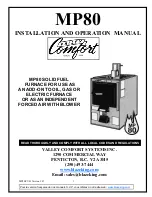
-- 47 --
Roof terminations
-- Locate assembly through roof to
appropriate height as shown in Fig. 42.
Sidewall terminations
-- Locate assembly through side wall with
rain shield positioned no more than 1-in. (25 mm) from wall as
shown in Fig. 42.
4. Disassemble loose pipe fittings. Clean and cement using
same procedures as used for system piping.
5. Check required dimensions as shown in Fig. 42.
Two-Pipe Termination Kit (Direct Vent/2-Pipe System Only
Determine an appropriate location for termination kit using the
guidelines provided in section “Vent Termination: General” in
this instruction.
1. Cut 2 holes, 1 for each pipe, of appropriate size for pipe
size being used.
2. Loosely install elbow in bracket and place assembly on
combustion-air pipe.
Roof terminations --
Loosely install pipe coupling on
properly cut vent pipe. Coupling must be positioned so
bracket will mount as shown in Fig. 42.
For applications using combustion-air pipe option,
indicated by dashed lines in Fig. 42, install 90
°
street
elbow into 90
°
elbow, making a U-fitting. A 180
°
U-fitting
may be used.
Sidewall terminations --
Install bracket as shown in
Fig. 42.
For applications using vent pipe option indicated by
dashed lines in Fig. 42, rotate vent elbow 90
°
from
position shown in Fig. 42.
3. Disassemble loose pipe fittings. Clean and cement using
same procedures as used for system piping.
4. Check required dimensions as shown in Fig. 42.
Multi--venting and Vent Terminations
When 2 or more 58MCB Furnaces are vented near each other,
each furnace must be individually vented. NEVER common vent
or breach vent 58MCB furnaces.
(Direct Vent/2-Pipe System ONLY) -- When 2 or more 58MCB
furnaces are vented near each other, 2 vent terminations may be
installed as shown in Fig. 42, but next vent termination must be at
least 36 in. (914 mm) away from first 2 terminations. It is
important that vent terminations be made as shown in Fig. 42 to
avoid recirculation of flue gases.
Step 11 -- Condensate Drain
GENERAL
Condensate trap is shipped installed in the blower shelf and
factory connected for UPFLOW applications. Condensate trap
must be RELOCATED for use in DOWNFLOW and
HORIZONTAL applications.
Condensate trap MUST be used for all applications.
An external trap is not required when connecting the field drain
to this condensate trap.
The field drain connection (condensate trap or drain tube
coupling) is sized for 1/2-in. (13 mm) CPVC, 1/2-in. (13 mm)
PVC, or 5/8 in. (16 mm) ID tube connection.
Drain pipe and fittings must conform to ANSI standards and
ASTM D1785, D2466 or D2846. CPVC or PVC cement must
conform to ASTM D2564 or F493. Primer must conform to
ASTM F656. In Canada, use CSA or ULC listed schedule 40
CPVC or PVC drain pipe, fittings, and cement.
When a condensate pump is required, select a pump which is
approved for condensing furnace applications. To avoid
condensate spillage, select a pump with an overflow switch.
OPEN STAND
PIPE FOR
A/C OR
HUMIDIFIER
DRAIN
TEE
TO OPEN
DRAIN
A94054
Fig. 44 -- Example of Field Drain Attachment
Furnace condensate is mildly acidic, typically in the pH range of
3.2 to 4.5. Due to corrosive nature of this condensate, a
condensate pH neutralizing filter may be desired. Check with
local authorities to determine if a pH neutralizer is required.
APPLICATION
The furnace, A/C, and humidifier drains may be combined and
drained together. The A/C drain must have an external, field-
supplied trap prior to the furnace drain connection. All drain
connections (furnace, A/C, or humidifier) must be terminated into
an open or vented drain as close to the respective equipment as
possible to prevent siphoning of the equipment’s drain.
See Fig. 44 for example of possible field drain attachment using
1/2-in. (13 mm) CPVC or PVC tee for vent and A/C or humidifier
drain connection.
Outdoor draining of the furnace is permissible if allowed by local
codes. Caution should be taken when freezing. Ambient may
freeze drain pipe and prohibit draining.
PERSONAL INJURY HAZARD
Caution should be taken to prevent draining where slippery
conditions may cause personal injuries.
Excessive condensate draining may cause saturated soil
conditions which could result in damage to plants.
!
WARNING
CONDENSATE DRAIN PROTECTION
Freezing condensate left in condensate trap and drain line may
cause cracks, and possible water damage may occur. If freeze
protection is required, use condensate freeze protection accessory
or equivalent 3 to 6 watt per ft at 120v and 40
°
F (4
°
C)
self-regulating, shielded, and waterproof heat tape. See
Installation Instructions supplied with accessory or heat tape
manufacturer’s recommendations.
1. Fold heat tape in half and wrap on itself 3 times.
2. Locate heat tape between sides of condensate trap back.
(See Fig. 45.)
58MCB







































